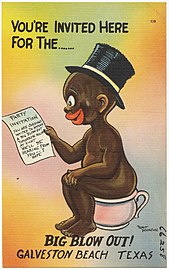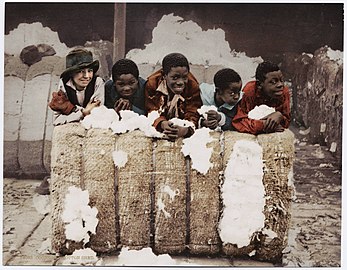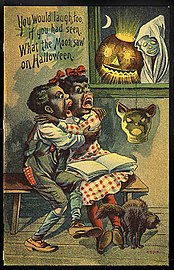
A postcard or post card is a piece of thick paper or thin cardboard, typically rectangular, intended for writing and mailing without an envelope. Non-rectangular shapes may also be used but are rare.

Blackface is the practice of non-Black performers using burnt cork or theatrical makeup to portray a caricature of Black people on stage or in entertainment.

A mammy is a U.S. historical stereotype depicting black women, usually enslaved, who did domestic work, including nursing children. The fictionalized mammy character is often visualized as a fat, dark-skinned woman with a motherly personality. The origin of the mammy figure stereotype is rooted in the history of slavery in the United States, as slave women were often tasked with domestic and childcare work in American slave-holding households. The mammy caricature was used to create a narrative of black women being happy within slavery or within a role of servitude. The mammy stereotype associates black women with domestic roles and it has been argued that it, combined with segregation and discrimination, limited job opportunities for black women during the Jim Crow era, approximately 1877 to 1966.
In the post-Reconstruction United States, Black Buck was a racial slur used to describe a certain type of African American man. In particular, the caricature was used to describe black men who absolutely refused to bend to the law of white authority and were seen as irredeemably violent, rude, and lecherous.
Racism has been reflected in discriminatory laws, practices, and actions at various times in the history of the United States against racial or ethnic groups. Throughout American history, white Americans have generally enjoyed legally or socially sanctioned privileges and rights, which have been denied to members of various ethnic or minority groups at various times. European Americans have enjoyed advantages in matters of education, immigration, voting rights, citizenship, land acquisition, and criminal procedure.

Stereotypes of African Americans are misleading beliefs about the culture of people with partial or total ancestry from any black racial groups of Africa whose ancestors resided in the United States since before 1865, largely connected to the racism and the discrimination to which African Americans are subjected. These beliefs date back to the slavery of black people during the colonial era and they have evolved within American society.

Coon songs were a genre of music that presented a stereotype of black people. They were popular in the United States and Australia from around 1880 to 1920, though the earliest such songs date from minstrel shows as far back as 1848, when they were not yet identified with "coon" epithet. The genre became extremely popular, with white and black men giving performances in blackface and making recordings. Women known as coon shouters also gained popularity in the genre.
Stereotypes of European Americans in the United States are misleading generalizations about the character, behavior, or appearance of European Americans by other Americans in the United States. For stereotypes about Americans by people of other nationalities, see Stereotypes of Americans.
There are stereotypes of various groups of people which live within the United States and contribute to its culture. Worldwide, a disproportionately high number of people know about these stereotypes, due to the transmission of American culture and values via the exportation of American-made films and television shows.
African Americans, and African American males in particular, have an ethnic stereotype in which they are portrayed as dangerous criminals. This stereotype is associated with the fact that African Americans are proportionally over-represented in the numbers of those that are arrested and convicted for committing crimes. It has appeared frequently in American popular culture, reinforcing the negative consequences of systemic racism.

The Jim Crow Museum of Racist Memorabilia at Ferris State University, Big Rapids, Michigan, displays a wide variety of everyday artifacts depicting the history of racist portrayals of African Americans in American popular culture. The mission of the Jim Crow Museum is to use objects of intolerance to teach tolerance and promote social justice.
White power music is music that promotes white nationalism. It encompasses various music styles, including rock, country, and folk. Ethnomusicologist Benjamin R. Teitelbaum argues that white power music "can be defined by lyrics that demonize variously conceived non-whites and advocate racial pride and solidarity. Most often, however, insiders conceptualized white power music as the combination of those themes with pounding rhythms and a charging punk or metal-based accompaniment." Genres include Nazi punk, Rock Against Communism, National Socialist black metal, and fashwave.
The representation of African Americans in speech, writing, still or moving pictures has been a major concern in mainstream American culture and a component of media bias in the United States.

The watermelon stereotype is an anti-Black racist trope originating in the Southern United States. It first arose as a backlash against African-American emancipation and economic self-sufficiency in the late 1860s.

The Jolly Darkie Target Game was a game developed and manufactured by the McLoughlin Brothers which was released in 1890. It was produced until at least 1915. Other companies produced similar games, such as Alabama Coon by J. W. Spear & Sons.

Concepts of race and sexuality have interacted in various ways in different historical contexts. While partially based on physical similarities within groups, race is understood by scientists to be a social construct rather than a biological reality. Human sexuality involves biological, erotic, physical, emotional, social, or spiritual feelings and behaviors.
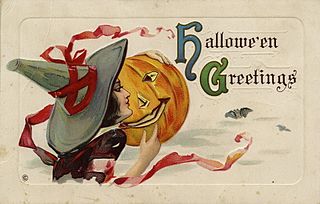
A Halloween card is a greeting card associated with Halloween. The concept originated in the 1890s United States, experiencing a peak of popularity there in the early 1900s. Until the advent of the common home telephone, Halloween cards occupied a role similar to Christmas cards and birthday cards. Today, many cards from the popular designers of the period are sought after as memorabilia.
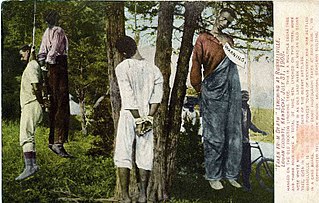
A lynching postcard is a postcard bearing the photograph of a lynching—a vigilante murder usually motivated by racial hatred—intended to be distributed, collected, or kept as a souvenir. Often a lynching postcard would be inscribed with racist text or poems. Lynching postcards were in widespread production for more than fifty years in the United States; although their distribution through the United States Postal Service was banned in 1908.
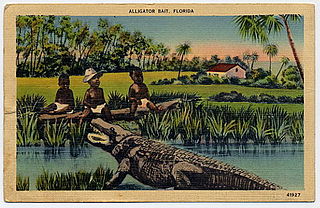
Depicting African-American children as alligator bait was a common trope in American popular culture in the 19th and 20th centuries. The motif was present in a wide array of media, including newspaper reports, songs, and visual art.

The fried chicken stereotype is an anti-Black racist trope that has its roots in the American Civil War and traditional slave foods.





